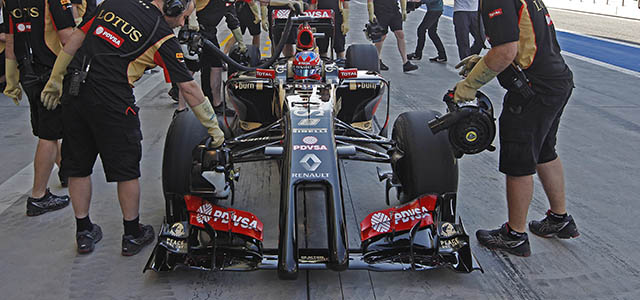
Chassis: Lotus F1 Team Class: F1 2014 Engine:Renault RS34 Energy F1 1.6L Turbo V6 Fuel: Petrol Transmission:8 speed sequential Brakes: Carbon/Carbon 0 Weight: – Fuel Tank: ATL Year introduced: 2014
Lotus revealed its 2014 F1 car the E22 via a post on twitter. The new car was not be at the opening test in Jerez despite having passed all of its crash tests. It is thought that this is due to issues in the supply chain, especially with the radiators and wiring looms.
“We’re going to keep our car under wraps a little longer than some other teams. We’ve decided that attending the Jerez test isn’t ideal for our build and development programme. We are likely to unveil the car before attending the Bahrain tests, and in Bahrain we should really be able to put the car through its paces in representative conditions” Technical Director, Nick Chester explained.
PRE LAUNCH
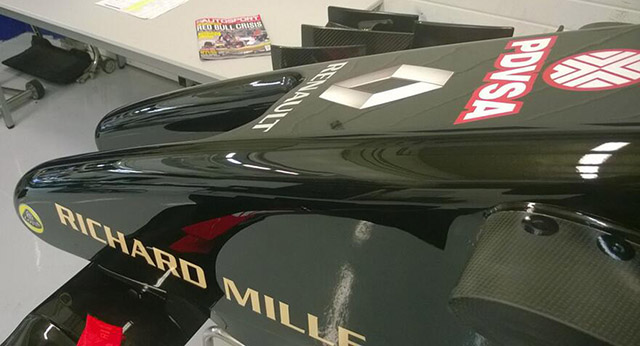
When the Lotus E22 was revealed in the form of a low resolution low detail rendering on Twitter it took many by surprise. Whilst most team have a single, low ‘ant eater’ nose the Lotus appears to have a pair of tusks (above). This approach is not unprecedented, the Audi R15+ LMP1 had twin front impact structures (below)
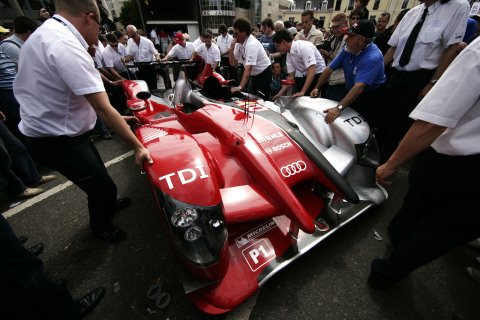
This was a good way for the team to get the aerodynamic effect it wanted as well as meeting the crash test regulations. However the 2014 Formula 1 Technical regulations state in 15.4.3 that
An impact absorbing structure must be fitted in front of the survival cell. This structure need not be an integral part of the survival cell but must be solidly attached to it. No part of this structure may lie more than 525mm above the reference plane. It must have a single external cross section, in horizontal projection, of more than 9000mm2 at a point 50mm behind its forward-most point. Furthermore :
a) No part of this cross-section may lie more than 250mm or less than 135mm above the reference plane.
b) The centre of area of this section must be no more than 185mm above the reference plane and no less than 750mm forward of the front wheel centre line.
But what it does not say is that a “single” impact absorbing structure must be fitted in front of the survival cell. In other words multiple structures could be used.

UPDATE
It now seem that Lotus has indeed utilised twin impact structures at the front of the car but they are not identical to one another, the one on the right house the primary impact structure, whilst the one on the left houses a shorter secondary structure. Both ‘tusks’ also support the front wing.
Racecar Engineering also understands from sources within the team that the E22 has a ver clever mechanism for transmitting torque from the power unit to the transmission, which offere much greater performance than others seen by some team suppliers.
TEST 02: SAKHIR, BAHRAIN
Lotus turned up at Bahrain with the E22 having run it for 100km in Jerez in early February. But only managed to eight laps on the board in Bahrain due to issues with the Renault power unit.
Alan Permane, Trackside Operations Director:
“Obviously that wasn’t the day we wanted to have and there are few conclusions we can draw so far as our running was so limited. It’s no secret that we’re frustrated as we want to get laps on the board to understand our new car and all the different elements it contains. The power units contain a lot of new technology and certainly we had issues with the energy store unit today. We changed this unit during the course of the day, which is not the work of a moment. Certainly we hope for a better day tomorrow.”

Here we get a first proper look at that nose. The uneven length of the twin crash structures is clear to see, but more interesting is the shape of the nose between them which looks very bluff, but could be channelling air under the front of the chassis. Note also the front brake duct design.
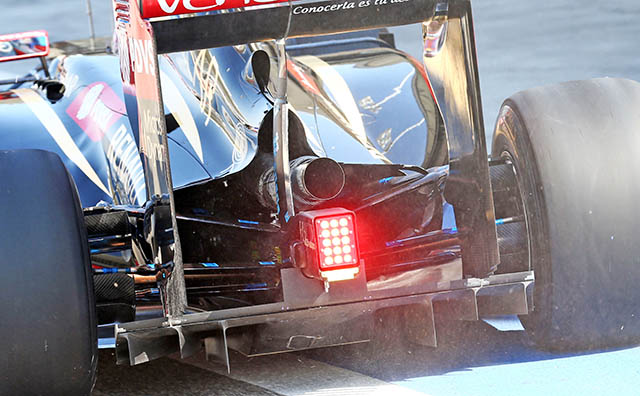
The rear end of the Lotus is quite interesting when you realise that the rear wing support is offset to one side. A single pillar avoids the exhaust exit and mounts to the left hand edge of the gearbox casing. Every other team on the grid has twin supports either via the end pates or twin pillars. It is interesting as with an unequal mounting the wing may put a greater load into the left rear than the right rear. Note also the hooded cooling exit on the centre of the engine cover.
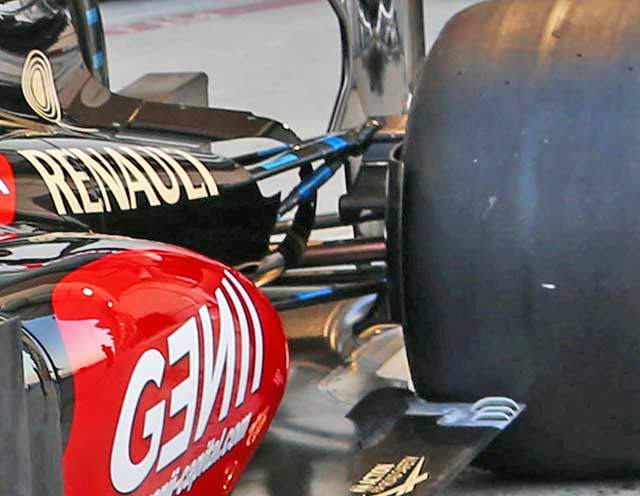
Looking at the rear of the E22 the pull rod rear suspension layout is clear. Lotus is the only Renault powered team not to use any element of the Red Bull RB10 transmission. Note the very large bodywork opening around the forward part of the upper wishbone. Also note the three holes ahead of the rear wheel on the cars floor. The light colour of this section suggests that it has come directly from the rapid prototyping department
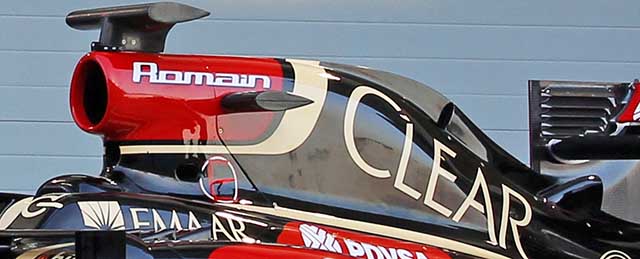
The E22 is unusual in that its roll hoop supporting legs are fully enclosed, only the Marussia shares this approach. The engine cover features a small fin on its upper edge as well as two cooling openings, the first seems to be placed to draw cooling air in, perhaps to the turbocharger, as when the car finished a run the Lotus mechanics attach a leaf blower directly onto it. The lower opening which is partly hooded appears to allow hot air to exit.
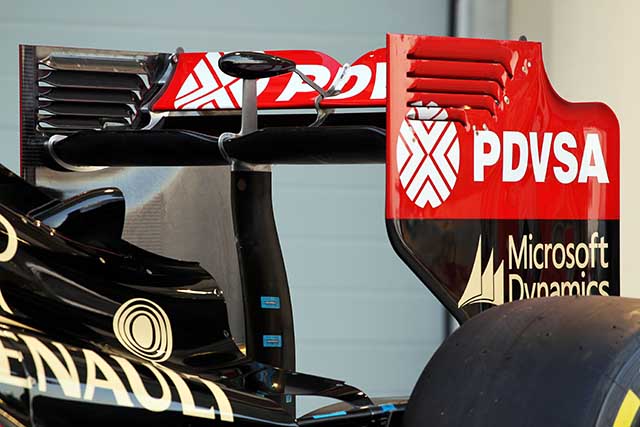
A good look at the rear wing of the E22, from this angle it is hard to see how off set the central support is.

Lotus conducted some flow visualisation work on the E22 during the test. The green dye reveals the airflow over the components it is applied to, clearly seen on the rear wing end plate (above). The wing elements themselves were also tested in the same way (below). Note also the kink in the tail pipe.

Other aerodynamic evaluation tools were run on the E22 as the team uses its limited testing time to get an understanding of the cars behaviour. This array has a large number of airspeed sensors all of which feed back to the cars on board logger.

Another look at the rear of the E22, this time from above where the kinked exhaust is clear to see.
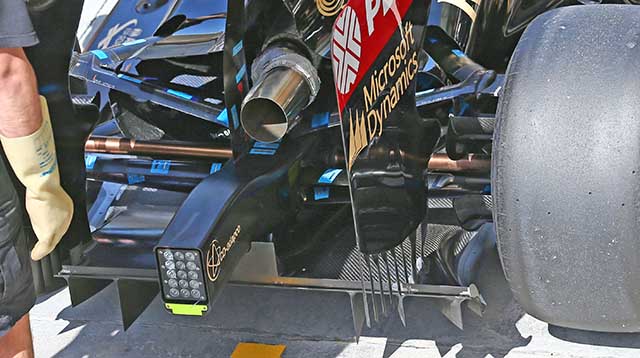
TEST 3: SAKHIR, BAHRAIN
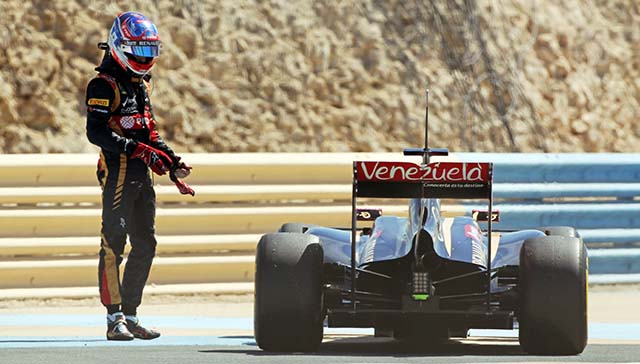
Its fair to say that the third pre-season test was a disaster for Lotus, having missed the first test as the E22 was not ready it needed to maximise its running at Sakhir. That did not happen, a new exhaust design failed, power units failed and at least once, something caught fire.
“We’ve ended our pre-season test programme with a lot of unknowns and a full workload for the days ahead. We’re all focused, both at Enstone and in Viry, on analysing all the data we have gained to make as much improvement as we can before we get to Australia for the first race of the season. Today we put some more mileage on the E22, but once again we stopped early, which is obviously not what we wanted. There will be some long days and nights before the first race but we are determined to make as much progress as possible” read a downbeat team press release.
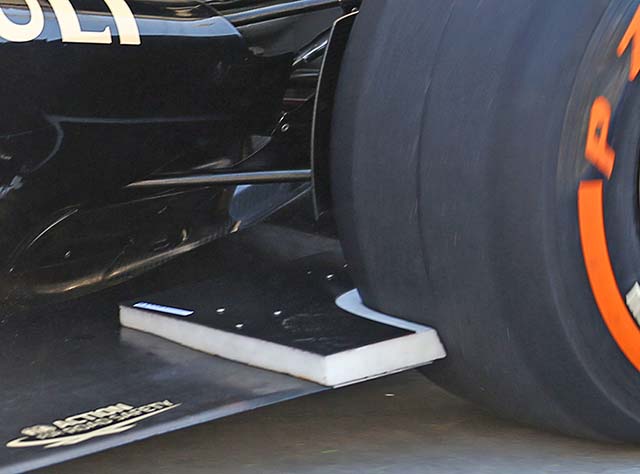
One of the few tests that Lotus did attempt was a tyre clearance test. Tyre sizes vary with speed and temperature, broadly speaking the faster the tyre rotates the bigger it gets but it is rather more complex than that and very hard to model accurately. So Lotus used a very simple solution to understand the required clearance. Stick a bit of foam on the rear floor, measure it and measure it again after a run to see how much has worn away.

Not all of the monitoring devices used by Lotus are quite as low tech, this sensor array was fitted to the rear of the car to monitor airflow ahead of the rear wing.

